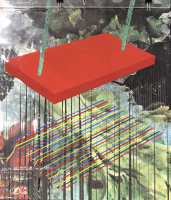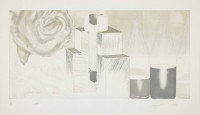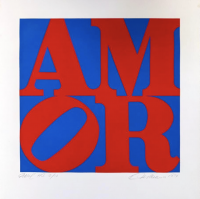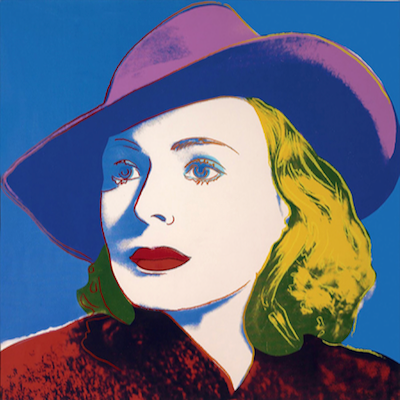
Details
Artist
Styles
Lithograph in colors on Twinrocker paper - Published by Bird Island Publishing - Printed by Vermilion Editions, Minneapolis - Signed, titled, dated, and numbered in pencil // Alphabet Avalanche by James Rosenquist, created in 1979, is a bold lithograph that embodies the artist’s fascination with fragmented imagery and dynamic composition. This limited edition print, produced in an edition of 85, showcases a striking combination of abstract forms set against a dark, textured background. The composition features two prominent shapes—a circular form filled with vibrant, striped patterns, and a semi-circular fan-like shape—linked by a diagonal, staircase-like structure that slices through the scene. The vibrant stripes and contrasting monochrome fan evoke a sense of movement, as if capturing an avalanche of shapes and colors tumbling across the paper. Rosenquist’s characteristic use of bright colors and juxtaposed textures creates a visually engaging piece that blends abstraction with hints of mechanical and architectural forms. Signed, titled, and numbered in pencil, Alphabet Avalanche invites viewers to explore its energetic arrangement, a testament to Rosenquist's innovative approach to contemporary art.
Alphabet Avalanche, 1979
form
Medium
Size
57 x 111 cm
- Inches
- Centimeters
Edition
Price
- USD
- EUR
- GBP
Details
Artist
Styles
Lithograph in colors on Twinrocker paper - Published by Bird Island Publishing - Printed by Vermilion Editions, Minneapolis - Signed, titled, dated, and numbered in pencil // Alphabet Avalanche by James Rosenquist, created in 1979, is a bold lithograph that embodies the artist’s fascination with fragmented imagery and dynamic composition. This limited edition print, produced in an edition of 85, showcases a striking combination of abstract forms set against a dark, textured background. The composition features two prominent shapes—a circular form filled with vibrant, striped patterns, and a semi-circular fan-like shape—linked by a diagonal, staircase-like structure that slices through the scene. The vibrant stripes and contrasting monochrome fan evoke a sense of movement, as if capturing an avalanche of shapes and colors tumbling across the paper. Rosenquist’s characteristic use of bright colors and juxtaposed textures creates a visually engaging piece that blends abstraction with hints of mechanical and architectural forms. Signed, titled, and numbered in pencil, Alphabet Avalanche invites viewers to explore its energetic arrangement, a testament to Rosenquist's innovative approach to contemporary art.
- Recently Added
- Price (low-high )
- Price (high-low )
- Year (low-high )
- Year (high-low )
James Rosenquist
Whipped Butter For Eugene, 1965
Limited Edition Print
Screen-print
Inquire For Price
James Rosenquist
Where The Water Goes (from The Welcome To The Water Planet), 1989
Limited Edition Print
Collage
Inquire For Price
James Rosenquist
Federal Spending (second State), 1978
Limited Edition Print
Etching And Aquatint
Inquire For Price
James Rosenquist
A Pale Angels Halo (Yellow), 1973
Limited Edition Print
Lithograph
Inquire For Price
James Rosenquist
Federal Spending, 1978
Limited Edition Print
Etching And Aquatint
Inquire For Price
James Rosenquist
Just Desert Israel 2nd State, 1979
Limited Edition Print
Intaglio
Inquire For Price
James Rosenquist
Window Washer Glass House (black And White), 1978
Limited Edition Print
Mixed Media
Inquire For Price
James Rosenquist
The Flame Still Dances On Leos Book, 1997
Limited Edition Print
Lithograph
Inquire For Price
James Rosenquist
The Kabuki Blushes (from Secrets In Carnations), 1986
Limited Edition Print
Mixed Media
USD 8,950
James Rosenquist
The Book Disappears For The Fast Student 2nd State, 1978
Limited Edition Print
Etching And Aquatint
USD 1,100
James Rosenquist
Spring Cheer, 1st. State , 1978
Limited Edition Print
Etching And Aquatint
USD 4,250
James Rosenquist
Sunglass Lens - Landing Net - Triangle, 1974
Limited Edition Print
Etching
Inquire For Price
James Rosenquist
The World Art Festival, 1982
Limited Edition Print
Lithograph
Currently Not Available
What is pop-art?
Pop Art is an art movement that began in Britain in 1955 and in the late 1950s in the U.S. It challenged traditional fine arts by incorporating imagery from popular culture, such as news, advertising, and comic books. Pop Art often isolates and recontextualizes materials, combining them with unrelated elements. The movement is more about the attitudes and ideas that inspired it than the specific art itself. Pop Art is seen as a reaction against the dominant ideas of Abstract Expressionism, bringing everyday consumer culture into the realm of fine art.


























































